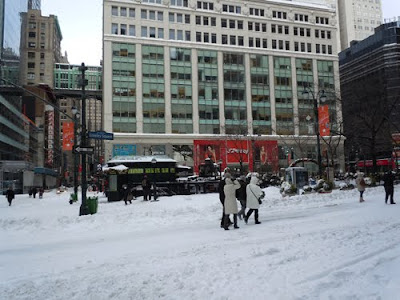
Elizabeth Rodriguez is the founder/poet/designer of
Go QuoteYourself !, a line of T-shirts and tote bags and other sundries that combine urban-inspired minimalist imagery with catchphrases conjured up by Epunto (she says it means “and period” in Spanish, which implies the last word, or words), her poetess alias. Amusing stuff.
One T-Shirt had LOL swirling like a flurry of bubbles around a simple slogan masquerading as definition: Low on Language, thus dispelling preconceptions that this was the well known internet idiom while also commenting on the pernicious aspects of the pervasiveness of that idiom. Another proclaimed I’m a LTD my time is now”. Incorporating the text, her poetry which takes the form of slogans—into a t-shirt or suitable design, a clever idea. I don’t mind such a loose definition of poetry—although to be pedantic, it’s more poetic than actual poem—she has a genuine flare for giving aphorism a texting veneer thus contemporary relevance. They’re catchy, provocative thoughts in a compelling graphic arts context.
She was at the final
Creative Grove of 2011, dressed for the cold weather. Elizabeth was wearing winter suspender pants with a sweater, which was under a knee-length sweater itself under a very warm looking long down jacket. She has a real energetic personality. The weather and the holiday cheer was making people giddy, which only augmented her natural vivaciousness.


Her mission statement says.. “It has been a long time since poetry paid a visit to the mainstream…”
Mainstream here being consumer items. A few days prior heard on the news that the MTA was phasing out its program of putting lines from poems in the NYC subway. Well, now it’s up to individuals like Epunto and t-shirts and tote bags.
“GoQuoteYourself!” was founded on the idea that philosophers and metaphor lovers still exist. That in the brightest and darkest of days a poet, a songwriter, or a stranger can say something so clever, insightful, or funny that it deserves to be quoted. Our designs are inspired, designed and financed by poets. It is our way of keeping alive the freedom transpired in words.” Compelling... freedom transpired in words, an internal freedom, about consciousness.
Epunto explains GoQuoteYourse! –“It is a movement of the mind.”—and says that she sells T-Shirts (and Tote Bags) that think.
I guess your heart is no longer just for your sleeve, or only your heart
 Windy Snow… morning after the blizzard, traipsing and trudging towards the PATH… this isn’t snow it’s wind, wind pushing the snow, get ready for the drifts... More than a foot fell… how much more is to be determined, but the wind made it look deeper.
Windy Snow… morning after the blizzard, traipsing and trudging towards the PATH… this isn’t snow it’s wind, wind pushing the snow, get ready for the drifts... More than a foot fell… how much more is to be determined, but the wind made it look deeper. Man digging out the car, between the plows and the gusts creating drifts, mountains of snow... hills at least
Man digging out the car, between the plows and the gusts creating drifts, mountains of snow... hills at least 
 The gift that keeps giving… our downtown mosquito factory now dormant… see how the wind has formed a pond in the frozen muck, where are your skates Hans?
The gift that keeps giving… our downtown mosquito factory now dormant… see how the wind has formed a pond in the frozen muck, where are your skates Hans?





































